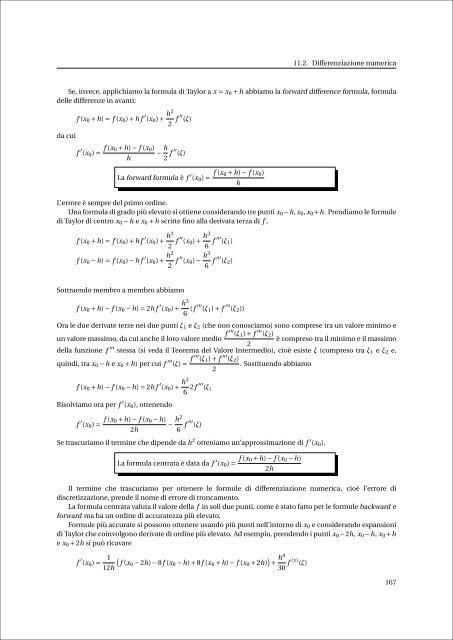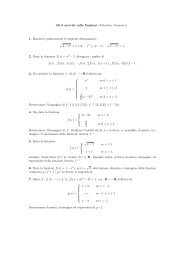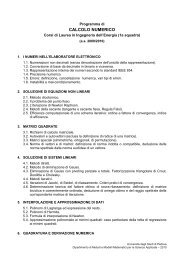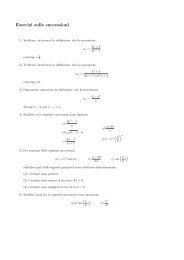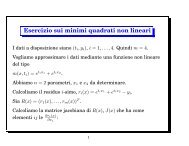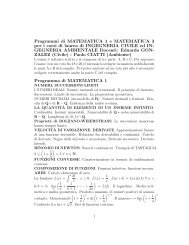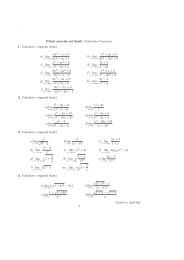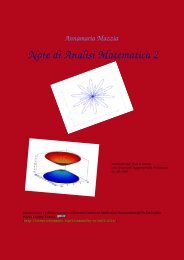Appunti di Calcolo Numerico - Esercizi e Dispense - Università degli ...
Appunti di Calcolo Numerico - Esercizi e Dispense - Università degli ...
Appunti di Calcolo Numerico - Esercizi e Dispense - Università degli ...
You also want an ePaper? Increase the reach of your titles
YUMPU automatically turns print PDFs into web optimized ePapers that Google loves.
11.2. Differenziazione numerica<br />
Se, invece, applichiamo la formula <strong>di</strong> Taylor a x = x 0 + h abbiamo la forward <strong>di</strong>fference formula, formula<br />
delle <strong>di</strong>fferenze in avanti:<br />
da cui<br />
f (x 0 + h) = f (x 0 ) + h f ′ (x 0 ) + h2<br />
2 f ′′ (ξ)<br />
f ′ (x 0 ) = f (x 0 + h) − f (x 0 )<br />
− h h<br />
2 f ′′ (ξ)<br />
La forward formula è f ′ (x 0 ) = f (x 0 + h) − f (x 0 )<br />
h<br />
L’errore è sempre del primo or<strong>di</strong>ne.<br />
Una formula <strong>di</strong> grado più elevato si ottiene considerando tre punti x 0 −h, x 0 , x 0 +h. Pren<strong>di</strong>amo le formule<br />
<strong>di</strong> Taylor <strong>di</strong> centro x 0 − h e x 0 + h scritte fino alla derivata terza <strong>di</strong> f ,<br />
f (x 0 + h) = f (x 0 ) + h f ′ (x 0 ) + h2<br />
2 f ′′ (x 0 ) + h3<br />
6 f ′′′ (ξ 1 )<br />
f (x 0 − h) = f (x 0 ) − h f ′ (x 0 ) + h2<br />
2 f ′′ (x 0 ) − h3<br />
6 f ′′′ (ξ 2 )<br />
Sottraendo membro a membro abbiamo<br />
f (x 0 + h) − f (x 0 − h) = 2h f ′ (x 0 ) + h3<br />
6 (f ′′′ (ξ 1 ) + f ′′′ (ξ 2 ))<br />
Ora le due derivate terze nei due punti ξ 1 e ξ 2 (che non conosciamo) sono comprese tra un valore minimo e<br />
un valore massimo, da cui anche il loro valore me<strong>di</strong>o f ′′′ (ξ 1 ) + f ′′′ (ξ 2 )<br />
è compreso tra il minimo e il massimo<br />
2<br />
della funzione f ′′′ stessa (si veda il Teorema del Valore Interme<strong>di</strong>o), cioè esiste ξ (compreso tra ξ 1 e ξ 2 e,<br />
quin<strong>di</strong>, tra x 0 − h e x 0 + h) per cui f ′′′ (ξ) = f ′′′ (ξ 1 ) + f ′′′ (ξ 2 )<br />
. Sostituendo abbiamo<br />
2<br />
f (x 0 + h) − f (x 0 − h) = 2h f ′ (x 0 ) + h3<br />
6 2f ′′′ (ξ )<br />
Risolviamo ora per f ′ (x 0 ), ottenendo<br />
f ′ (x 0 ) = f (x 0 + h) − f (x 0 − h)<br />
− h2<br />
2h<br />
6 f ′′′ (ξ)<br />
Se trascuriamo il termine che <strong>di</strong>pende da h 2 otteniamo un’approssimazione <strong>di</strong> f ′ (x 0 ).<br />
La formula centrata è data da f ′ (x 0 ) = f (x 0 + h) − f (x 0 − h)<br />
2h<br />
Il termine che trascuriamo per ottenere le formule <strong>di</strong> <strong>di</strong>fferenziazione numerica, cioè l’errore <strong>di</strong><br />
<strong>di</strong>scretizzazione, prende il nome <strong>di</strong> errore <strong>di</strong> troncamento.<br />
La formula centrata valuta il valore della f in soli due punti, come è stato fatto per le formule backward e<br />
forward ma ha un or<strong>di</strong>ne <strong>di</strong> accuratezza più elevato.<br />
Formule più accurate si possono ottenere usando più punti nell’intorno <strong>di</strong> x 0 e considerando espansioni<br />
<strong>di</strong> Taylor che coinvolgono derivate <strong>di</strong> or<strong>di</strong>ne più elevato. Ad esempio, prendendo i punti x 0 −2h, x 0 −h, x 0 +h<br />
e x 0 + 2h si può ricavare<br />
f ′ (x 0 ) = 1 (<br />
f (x0 − 2h) − 8f (x 0 − h) + 8f (x 0 + h) − f (x 0 + 2h) ) + h4<br />
12h<br />
30 f (v) (ξ)<br />
167


